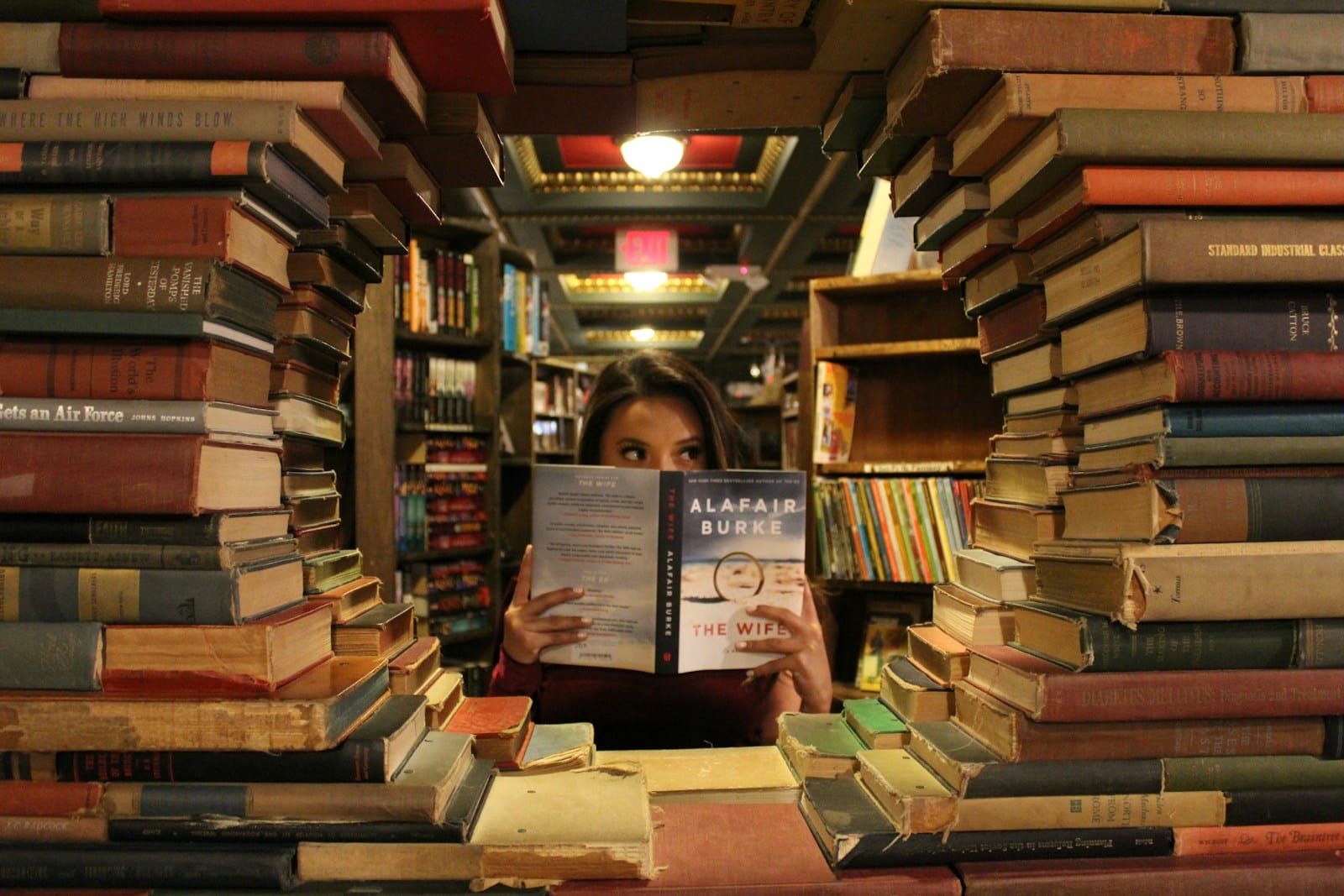When I was five years old, my dad gave me my first book recommendation.
He walked me to our local library and pulled out a picture book about a group of fish that came together to escape a fisherman’s net. It was simple and memorable.
I loved that book.
More than twenty-five years have passed since then, and by now I’ve probably read somewhere between 500 and 600 books.
When I was younger, I would read anything I could find. Whatever I picked up at the library, I would finish. Even if it wasn’t great, I didn’t think much of it — I was just happy to be reading. Back then, there were no e-books or online options. The only books available to me were the ones inside that one library, and their limits were my limits.
But once I started my undergraduate studies, the story changed. I was always thinking about how to find a good book to read. And more often than not, I found myself struggling with it. Looking back, I see two reasons why:
- There were suddenly too many options.
- My time for reading had become limited.
I needed a way to figure out how to find a good book to read without wasting time.
The danger here is subtle: when you spend more time searching for books than reading them, your mind normalizes it. You convince yourself, this is just how it is. But those hours of indecision add no value.
Here’s how I broke out of that cycle of indecision and started reading more.
Key Takeaways:
1
There are plenty of good books out there, but the real challenge is finding the one that fits you.
2
Ratings — especially rating distributions — help cut through the noise. But they’re not perfect, because at the end of the day it’s about taste, not perfection.
3
The best approach is a mix: use ratings as a guide, then lean on trusted recommendations from people whose judgment you respect.
The Real Problem: Finding the Right Fit
It’s not that there aren’t enough good books. The problem is almost the opposite: there are far too many. Most books being published are good in some way.
Think about movies. Sometimes you’ll watch one and think, I get what they’re trying to say, but the script just isn’t working. Books are like that, too. A flawed execution doesn’t always mean there’s no value.
There are four main categories of books:
- Well-written and built on a solid thesis.
- Well-written but based on a lousy thesis.
- Badly written but with a solid thesis.
- And then there’s the rarest kind of all — both badly written and built on a lousy thesis.
The good news is that traditional publishing provides some level of screening. Because of this, that last category second category are uncommon; publishers usually filter them out.
Which means, in practice, most books we come across aren’t truly terrible — they’re just not the right fit for us.
The Overwhelming Number of Choices
So the question becomes: how do you find the book that fits you best?
If you’ve ever scrolled through Goodreads or Amazon, you know the feeling. Millions of titles. Endless lists. And then there are the millions of recommendations scattered across blogs, TikTok, YouTube, and every corner of the internet. It’s constant noise — a bombardment of opinions.
These all could be great choices.
But, what can we actually trust?
The simplest, most straightforward method is to look at ratings.
Starting With Ratings
Ratings are easy to work with because they’re quantifiable. They give us a sense of how other people responded, and at the very least, they offer a place to start.
Take the broader view for a moment — not books, but products in general. With things like phones, blenders, or laptops, the pattern is usually clear:
- High average ratings (4–5★) signal reliable, consistent performance.
- Low average ratings (1–2★) point to recurring problems or defects.
- Tight distributions show broad consensus that the product works as advertised.
- Polarized distributions — lots of 1★ and 5★ reviews — usually mean the product is good but unreliable. In other words, it works beautifully when it works, but it tends to break down often.
Ratings are clearly helpful and play a big role in consumer buying decisions — as they should.
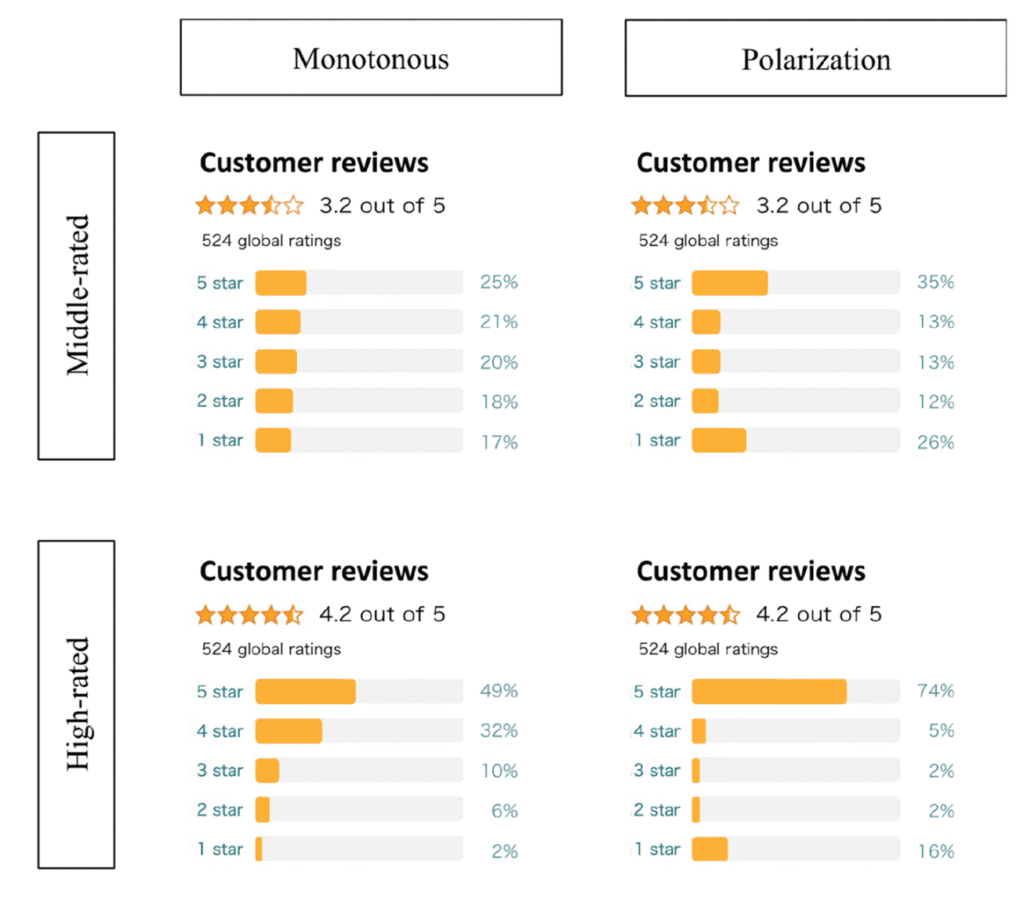
So how can we take the same approach and use it to choose a good book? How to choose books based on ratings?
Search Goods vs. Experience Goods
There’s a big difference between a commercial product like a TV or laptop and a book. Books are experience goods — you can’t really know their value until you’ve consumed them. Electronics, on the other hand, are search goods — you can check specs, benchmarks, and reliability data before buying.
That’s why book ratings tend to reflect subjective enjoyment more than “objective quality.” Your mood, your taste, the genre, even the timing of when you read it — all of it matters.
What Book Rating Distributions Actually Tell Us
A lot of research has already been done on this, so we don’t have to. The results are interesting — and, should I say, more optimistic than you might expect.
- Narrow clusters around 4★ usually mean broad appeal — books most people enjoy.
- Polarized splits, with lots of 1★ and 5★, often point to experimental, divisive, or niche books.
- Consistent 5★ ratings usually show genre fiction with a loyal fan base.
- Lower averages, 2–3★, usually reflect a mismatch between marketing and audience.
This means books with mixed ratings aren’t “bad.” They’re just reaching different readers. For example, a book with lots of 1★ and lots of 5★ reviews doesn’t mean it’s bad. More often, it just shows taste division.
The writing style or pacing might appeal strongly to some readers but frustrate others. Genre-bending or unusual themes can split opinions. Marketing might set the wrong expectations. And some books just inspire strong reactions — people tend to either love them or dislike them.
One person’s favourite can be another’s DNF(Did not finish).
Takeaway: If you like bold, challenging, experimental work, polarized reviews can be a green flag. If you prefer safer, broadly liked books, look for ratings clustered around 4★ or 5★.
Beyond Ratings: The Hybrid Method
Obviously, this isn’t a perfect “works-all-the-time” method for finding the right book. For instance, I looked at the Goodreads ratings of my top ten favorite books. Three of them didn’t have polarized splits or low averages. If I had just gone along with the ratings, I would have missed out on reading them.
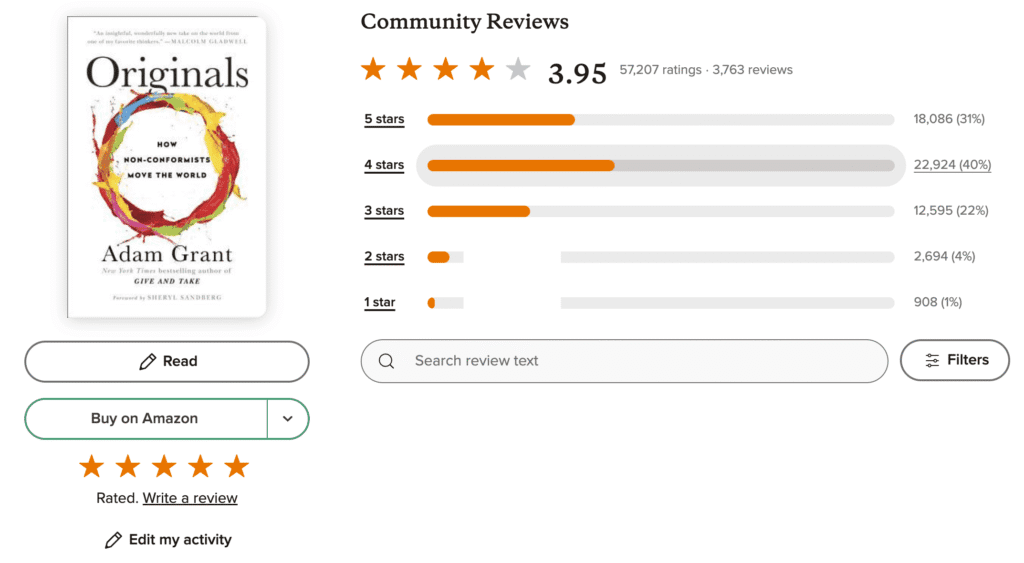
Some books I disliked — ones I thought weren’t worth my time — had tight distributions at 5★. So clearly, the rating approach doesn’t work every time.
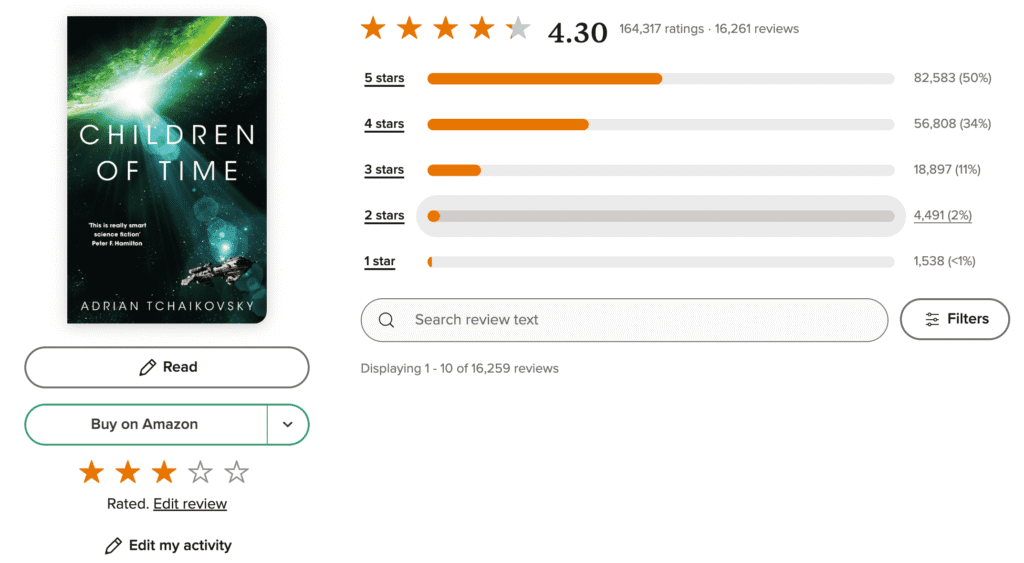
I needed something else to ‘reinforce’ my rating distribution approach.
The solution? Humans.
I realized the best method is still human: get recommendations from someone you trust, someone whose taste you respect. That’s the closest thing to what my dad gave me at five years old — a recommendation that didn’t just fit, but sparked something in me.
And we all do this. That’s why, when shopping on, say, Amazon, you don’t just stop at the ratings; you scroll down to see what people actually say.
Here’s how I do it: pick a person you admire — an author, thinker, or any figure whose judgment you respect. It’s not about the content they like; it’s about how they think — is it logical, thoughtful, humane?
If the answer is yes, I start by looking at the books they recommend — or their own books. Then I check the ratings of those books, mostly to help me organize my reading schedule(More on this on the section below). I pay attention to both what they like and what they don’t, to get a balanced view. This works for fiction and nonfiction alike.
One thoughtful recommendation can save you weeks of scrolling, searching, and second-guessing. It’s like building your own pyramid of trust — a network of people whose suggestions you know won’t waste your time.
You can also strengthen this approach with other sources: critics and awards (NYT, Pulitzer, Booker), scholarly citations, longevity — books that stood the test of time — and word of mouth from trusted friends or communities.
Over time, these two approaches(recommendations and ratings) start to feel like one seamless process. The best part? Once you get used to it, it only takes a couple of minutes to find a good book to read.
An Example of the Hybrid Method
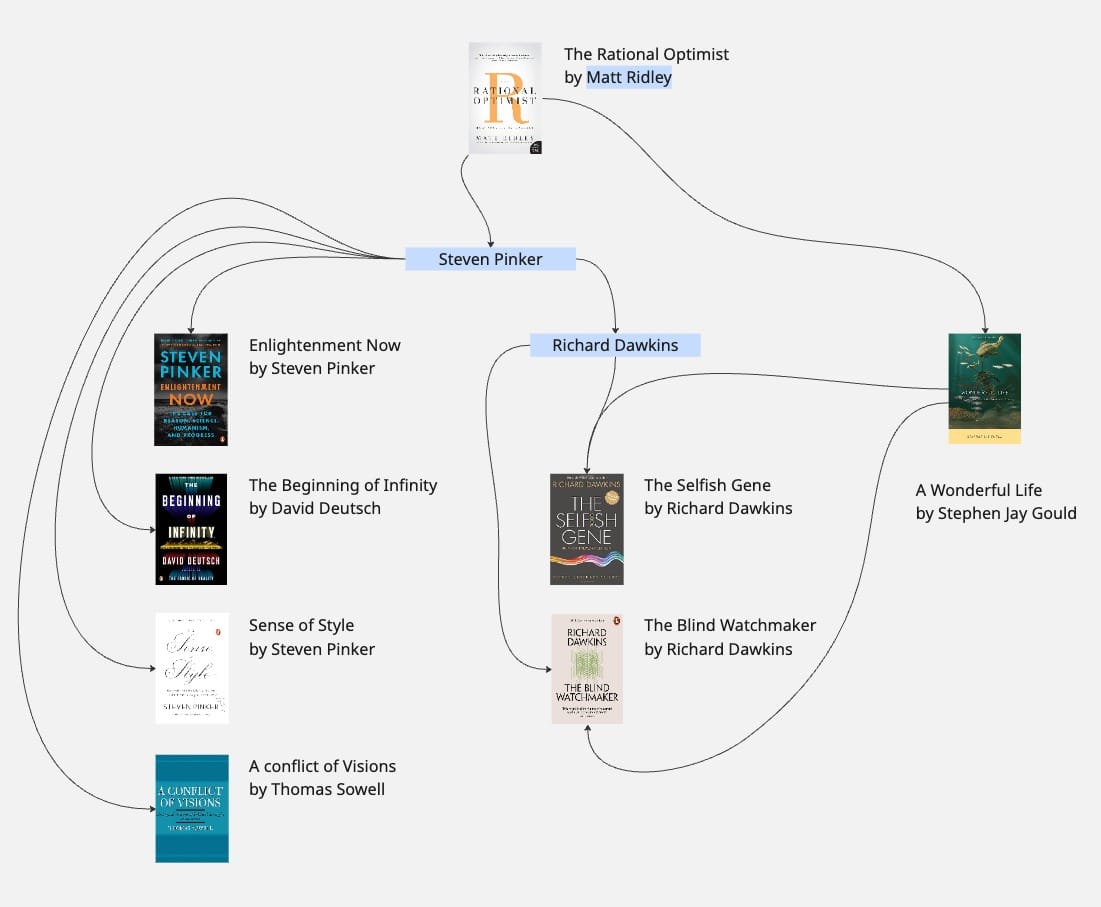
Here’s a recent rabbit hole of mine while hunting for books.
I picked up The Rational Optimist by Matt Ridley because so many people I follow recommended it. The ratings were mostly around 4★ — good, but not 5★, which told me opinions varied. That didn’t stop me; recommendations from people I trust mattered more. But the ratings reminded me to slow down. I read no more than 20 pages a day, took notes, and wrote a review at the end.
I loved how Ridley thinks.
That led me to Wonderful Life by Stephen Jay Gould because I wanted to explore a point Ridley discussed. It ended up being one of my favorite books of the year.
Following Ridley, I discovered debates he participated in. In one debate, I noticed a familiar face: Malcolm Gladwell, whose books I’ve read. But more importantly, I saw Steven Pinker on his side.
I hadn’t checked out his work yet, but once again, I liked the way he thinks.
From there, I dove into Pinker’s other videos, which led me to The Sense of Style. The ratings peaked at 4★, which told me it might be a bit of a challenging read, so I set aside two weeks for it. Another book, Enlightenment Now, had ratings peaking at 5★, which suggested it would be an easier, more widely enjoyed read. I planned to tackle that one over a long weekend.
Pinker also introduced me to other recommendations, like The Beginning of Infinity. He often talks about Richard Dawkins and Thomas Sowell. I’d read some of Sowell’s work, but not Conflict of Visions, which Pinker mentioned. That gave me the green light to add it to my list.
Next, Pinker led me to Dawkins. The Selfish Gene and The Blind Watchmaker sounded interesting — potentially rethink some ideas I picked up from Gould’s Wonderful Life.
In just this one rabbit hole, I ended up with two months’ worth of reading lined up. More importantly, it helps me plan and manage my time so I can actually focus on reading and keep a smooth, enjoyable flow.
Coming Full Circle
At the end of this whole process, I realize it all comes full circle — back to my first book recommendation from my dad.
But now my approach is more accurate, thoughtful, and mature.
It’s about getting recommendations from people you admire while also “adjusting and customizing” them to fit your own taste — using rating distributions as a guide. Knowing how to choose books based on ratings makes it even easier.
Conclusion
The challenge of picking your next book isn’t about separating good from bad. It’s about finding the right fit for you — balancing ratings, understanding distributions, and leaning on trusted recommendations.
With products, distributions help spot defects, reliability, and measurable quality. With books, they show audience fit and taste differences. A 5★ average isn’t automatically “better” than a polarized one — it all depends on you. Choosing your next book is really about matching your taste to the story the ratings are telling.
FAQs
How should I interpret a book’s star rating? Is the average enough?
Not always. A narrow cluster around 4★ or a peak at 5★ usually means the book appeals to a lot of people. But if the ratings are polarized — lots of 5★ and 1★ reviews — that usually signals a taste divide. For books, rating distributions tell you more about fit than about objective quality.
A book has mixed (polarized) reviews — should I still read it?
Yes — if you enjoy books that challenge you or split opinions. And if you decide to read one, it’s a good idea to take it slow. That way, you get the most out of it and can really have a “conversation” with the author or the characters. This is part of learning how to find a good book to read for your taste.
Critics gave glowing reviews, but readers are lukewarm. What does that tell me?
In cases like this, the best approach is to personalize your choice. Does it match your own preferences? If yes, that’s a green flag — even if most readers aren’t loving it.
Critics often focus on the “objective quality” of a book, but they can miss the impact it has on real readers. And the opposite can happen too.
Are online review ratings reliable?
Reviews are obviously useful, but “reliable” is a different story. There’s no real way to measure a book’s “objective” quality. Someone else’s all-time favorite could easily end up as a DNF (did not finish) for you.
The smartest way to use online reviews is to combine them with your own preferences — ideally, along with recommendations from people you trust. This is one of the best ways to figure out the best way to pick a book to read.
Should I prioritize ratings over author or cover?
No — studies show that things like the author, the cover, your familiarity with the author, and the book description usually matter more, with reviews and ratings just being one piece of the puzzle.
So it’s best not to pick a book based only on ratings. Look at the bigger picture instead.
I want a book similar to those I loved. How do I use ratings/distribution to find ‘read-alikes’?
One way to do this is to look up books you’ve loved on Goodreads or Amazon. Both sites are super user-friendly and usually suggest similar titles.
Next, see how those suggestions line up with your own preferences. You can check the rating distributions or think about recommendations from people you trust. Look for books with similar rating patterns — for example, tightly clustered versus polarized reviews.
You can also try reader-advisory tools like The StoryGraph, which let you filter books by mood, pacing, and other factors that matter to you. Using these tools can make how to find a good book to read much faster and more precise.

